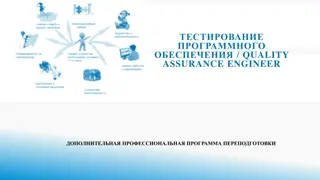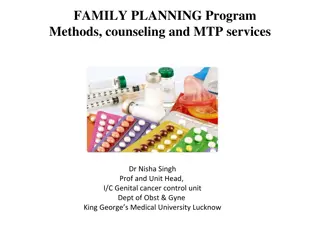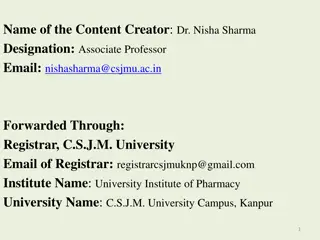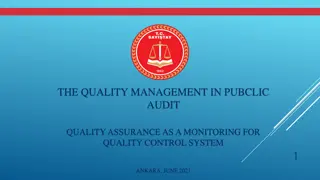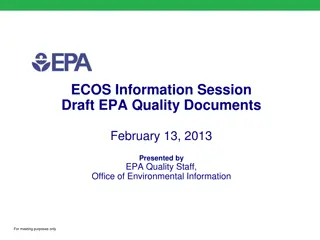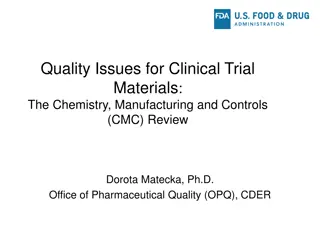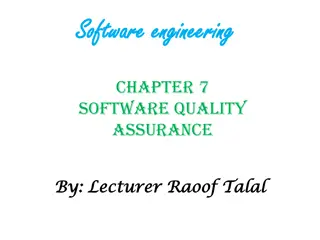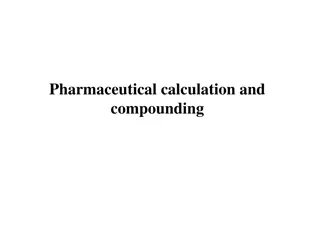Pharmaceutical Quality Assurance: Unit V - Warehousing Practices by Dr. Nisha Sharma
Explore the importance of good warehousing practices in the pharmaceutical industry as discussed in the 6th-semester course of Pharmaceutical Quality Assurance. Dr. Nisha Sharma elaborates on the concepts of warehousing, GWP, key activities, functions, and elements of good warehousing practices, emphasizing safety, hygiene, and efficiency in storage and distribution.
- Pharmaceutical Quality Assurance
- Warehousing Practices
- Dr. Nisha Sharma
- Supply Chain Management
- Pharmaceutical Regulations
Download Presentation

Please find below an Image/Link to download the presentation.
The content on the website is provided AS IS for your information and personal use only. It may not be sold, licensed, or shared on other websites without obtaining consent from the author. Download presentation by click this link. If you encounter any issues during the download, it is possible that the publisher has removed the file from their server.
E N D
Presentation Transcript
B. PHARM. 6THSEMESTER Pharmaceutical Quality Assurance UNIT V Warehousing: Good warehousing practice, materials management Dr. Nisha Sharma Associate professor University Institute of Pharmacy C.S.J.M. University, Kanpur
WAREHOUSING Warehouse: Place where raw material or finished products are stored before their distribution to ensure quality, safety, efficacy. Good warehousing Practices GWP: storage of supplies so that products are always available in good condition. It is an operation that preserves the integrity of drugs. Written procedure: describe the storage conditions of drugs, temp. humidity, light required IMPORTANCE OF Good warehousing Practices GWP: Optimizes resources for large scale storage in specified manner Integral part of supply chain Save time/effort to identify & locating products Controls the movement & storage of material in stores Helps easy stock take, stock verification & stock corrections Concept of zone product wise segregation Streamline the process of retrieval, storage & distribution Regulatory requirement for Pharmaceuticals
WAREHOUSING Good warehousing Practices: Warehousing & storage is an act of storage & assorting finished goods so as to create maximum time utilization at minimum cost. Key activities are Receiving Identifying Holding Assembling & processing of orders to meet demand Functions of warehousing: Receiving & recording of Goods: Responsibility of Ware house dept. to check & verify goods by weighing the shipper coming in and counting the same at the time of receipt. & record. Person transferring and person receiving should sign Storage: Stored such that it is easy to identify as per category. Zone concepts are good. 1. 2.
WAREHOUSING Functions of warehousing: 3. Order Picking: Once order has been received, line manager must ensure to pick same order as indicated in picking list & same batch number should be mentioned on all documents like: invoice, picking list, delivery note etc. 4. Distribution: Line managers hand over goods to the packers who verify goods against the delivery note & mark on shippers as per customer. Loading supervisors must check vehicle & confirm by matching the requirements, clean, tidy loading. ELEMENTS OF GOOD WAREHOUSING PRACTICES: 1. Cost involved in warehouse: follow First expiry first out (FEFO) for finished goods, provides maximum shelf life to inventory. 2. Stock verification: Ordered, timely, frequent stock verification gives correct stocks. Non moving, dead stock, near expiry products data must be shared with supply chains, planning dept. to decide the strategy.
WAREHOUSING ELEMENTS OF GOOD WAREHOUSING PRACTICES: 3. Safety: Occupational Health & safety assessment series (OHSAS 18001), British standards, protective garments PPE, helmets, safety shoes, garments, masks are essential. Warehouse employees should be disciplined. Fire end emergency & exit plans & fire drill need to made to validate the exit plan. Pest control activities, rodent baits must be checked regularly. 4. Premises, Health, Hygiene : Area must be Clean, free from smoke, dust, contaminants, ventilated, must protect goods from adverse weather, Floors must be non slip, even etc. walls to be smooth, impervious, durable etc., ceiling, doors, adequate light, toilets, storage conditions for cold storage 2-8 C, No overloading, cleaning equipments at appropriate places etc. 5. Good documentation : Documentation of all activities done. SOP records, Bin card, checked, updated, followed, maintain invoices, delivery notes, other docs.
WAREHOUSING CHARACTERISTIC OF GOOD WAREHOUSING Systematic storage of various categories of materials/products Storage of each material/product at specific place Proper cleaning & sanitation Control of air, light, temperature & humidity Safety measures for warehouse staff & stocked goods Clear labeling of products stored on the shelves Protection against pests and rodents Separate stock card for each material Storage of hazardous, poisonous and flammable/explosive materials in separate places. 1. 2. 3. 4. 5. 6. 7. 8. 9.
WAREHOUSING Warehousing staff: Pharmacist- stock mgt. safety, preservation of stock. Receiving, storage, issue, maintain stock are the duties. Workers of warehouse- handling operations, carrying & moving the stock for storage, shipment & sale. Cleaners: cleanliness of premises, equipments of handling. Security staff: for security of warehouse. Warehousing of raw & packaging materials Warehousing of intermediate & bulk products Warehousing of finished products: key requirements: Adequate number of qualified & trained staff Regular cleaning & sanitation of the warehouse areas Sufficient capacity area to store, quarantine, releasing, rejected, returned, recalled products Temperature & RH 1. 2. 3. 4. a) b) c) d)
WAREHOUSING e. Clear labeling & marking over storage containers for quick identification & controlled stock movement f. Effective pest and rodent control g. Periodic stock reconciliation h. Store rotation based on First in first out (FIFO) basis i. Proper documentation for storage, handling & transportation of stock.
MATERIAL MANAGEMNET It is concerned with Planning, organizing, controlling the flow of materials from their initial purchase through internal operations to the final stage of production and service point by distribution. Objectives: Gains economy in purchasing Satisfy demand during period of replenishment Carry reserve stock to avoid stock out Stabilize fluctuations in consumption Provide reasonable level of client services Have adequate materials in hand when required Minimize the inventory investment Operate efficiently Pay lowest possible prices, consistent supply & value requirement for purchase materials.
MATERIAL MANAGEMNET Principles of Material Management : Effective management & supervision: It depends of managerial functions of Planning, Organizing, Staffing, directing, controlling, reporting, budgeting Sound purchasing methods Skillful & hard poised negotiations Effective purchase systems Must be simple Must not increase other costs Simple inventory control programs 1. 2. 3. 4. 5. 6. 7.
MATERIAL MANAGEMNET FUNCTIONS OF MATERIAL MANAGEMENT DEPARTMENT Materials planning: Basic function of the materials Mgt department to tell the material requirement of future and ensure that required materials are available in time & at low cost. Purchasing: Efficient & economic purchasing results in reduced operating cost & adds to profits Procurement of quality materials: Main function of materials department to ensure that only materials of standard quality should be procured Lower inventories: If inventories are kept low, less capital is required in inventories and results in gaining profits Regular supply: For uninterrupted production continuous supply of materials is must, hence controls production cost. Efficient handling: By using effective material control techniques production cost can be lowered 1. 2. 3. 4. 5. 6.
MATERIAL MANAGEMNET FUNCTIONS OF MATERIAL MANAGEMENT DEPARTMENT 7. Efficient production scheduling: The dept. helps in efficient scheduling of production by ensuring availability of required materials in a timely manner 8. Specifications & standardization of materials: The dept. prepares specifications and standardizes the materials. 9. To take make or buy decisions: The materials dept. reviews cost & availability of materials on regular basis & can conclude whether it is economic to purchase the materials or to manufacture self. 10. Enhancement of firm s goodwill: This is also one of the functions of the depart. To maintain good relations with the suppliers of materials, that increases firms goodwill in business community.
MATERIAL MANAGEMNET FUNCTIONS OF MATERIAL MANAGEMENT DEPARTMENT 11. Product design & development: Materials dept. also assists in product design & development. 12. Co-ordination with other departments: Efficient working of materials department is essential for the success of every other dept. in the organization. The success of Materials dept also depends upon how effectively it coordinates with the staff of other dept. 13. Manpower development: Material dept. devotes efforts in locating, training & developing talented personnel who can take responsibilities of the business relating to materials management in future.
STAGES OF MATERIAL MANAGEMNET General controls: Follow written procedures for Receipt, identification, storage, quarantine, testing & approval/rejection of materials. Manufacturers of critical materials used in Mfg should be evaluated properly. If suppliers of material is not the Mfg of that material the name, address of Mfg. should be disclosed by the supplier. Receipt and Quarantine: On receiving & before acceptance, each container of material should by be examined for labeling, container damage, broken seals or evidence of any tampering or contamination. It should be checked that received consignment corresponds to the order placed. Unique code/batch or receipt no. should be allotted to identify the containers. While disposition of materials the unique code allotted should be recorded. The incoming material is stored under quarantine. 1. 2.
STAGES OF MATERIAL MANAGEMNET 3. Sampling & testing of incoming materials: Release of materials should be done only after proper testing. For Materials received from new suppliers, three batches should be analysed and the results must be comparable with the certificate of analysis supplied. This is known as in house verification. Sampling to be conducted as per defined sampling plan which includes sample size, number of containers to be sampled, which part of container to be sampled. Containers from which samples are taken must be marked. 4. Storage & issue of materials: Proper storage prevents degradation, contamination, and cross contamination of materials. Any damage to be recorded, informed to QC dept. Materials should be kept in drums, bags, boxes or racks/shelves above ground to allow proper cleaning and inspection. Storage at req. temp., relative humidity etc.
STAGES OF MATERIAL MANAGEMNET Rejected materials if any must be quarantined separately. Receipt & issue of each lot of material should be entered properly in the stock register/ card. Issue of materials should be made only upon written request. Hazardous material under supervision of responsible person. 5. Returned Goods: identified Reasons of return, isolation on receipt, must be maintained in writing. QC manager to examine for any reprocessing or destruction procedures & instruct accordingly. 6. Re evaluation: Materials should be re evaluated/ retested at proper intervals to determine their suitability for use.
REFERENCES Pharmaceutical Quality Assurance, Paul SD, Heswani G, Ed. 2019, S. Vikas and Company, Punjab. New Concepts in Pharmaceutical Quality Assurance, ChakrabortyAK, Manekar SS, Rathod SM, Ed. 2020, S. Vikas and Company, Punjab. Pharmaceutical Quality Assurance, BP Nagori, A Gaur, R Solanki, V Mathur, 2018, Scientific Publishers Jodhpur.





